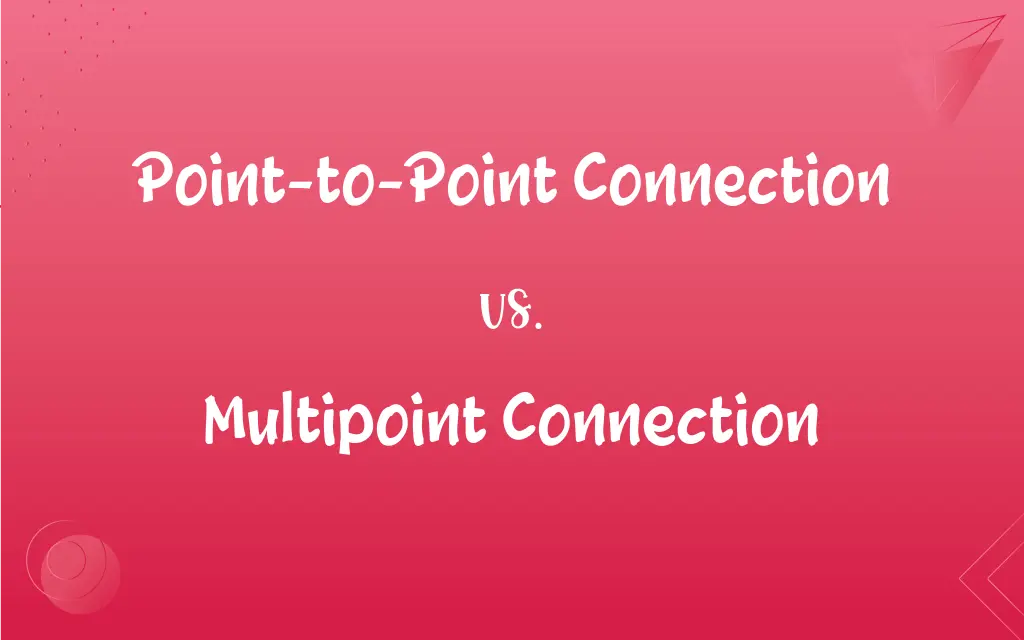Point-to-Point Connection vs. Multipoint Connection: What's the Difference?
Edited by Aimie Carlson || By Harlon Moss || Updated on October 10, 2023
Point-to-point connection involves a direct link between two devices, while multipoint connection supports links between three or more devices in a network.

Key Differences
Point-to-point connection and multipoint connection illustrate two contrasting approaches in establishing communication channels in network systems. Point-to-point connection, as the name itself suggests, characterizes a direct communication link established between two networking nodes. The straightforwardness of point-to-point connections can often render them an optimal choice for connecting two locations with a dedicated and frequently robust channel, often guaranteeing a certain level of performance and security due to its exclusivity between the two end points.
On the other hand, multipoint connection signifies a system where more than two specific points, devices, or nodes are connected through the same communication channel. In multipoint connections, data transmission may occur between any pair of devices connected to the shared channel. The complexity of managing data transmissions between various nodes and ensuring that the shared medium is utilized effectively without excessive data collisions or interference is intrinsic to multipoint configurations.
Point-to-point connections, with their dedicated channels, typically offer a simplicity that can be an asset in ensuring data integrity and consistency in communication. The straightforwardness of ensuring data is transmitted efficiently without the need to navigate through multiple nodes or manage access to a shared medium is a prominent advantage of point-to-point connections, particularly in contexts where data reliability and integrity are paramount.
Multipoint connections, conversely, provide a channel where numerous devices can communicate, promoting an environment conducive to integrated systems where multiple devices require interconnectivity. The advantages of multipoint connections, such as reduced physical infrastructure and the capability to facilitate broader communication networks, are tempered by challenges related to managing data transmissions, avoiding collisions, and ensuring all nodes can effectively communicate without interference or data loss.
Both point-to-point and multipoint connections carry respective advantages and challenges, making them suitable for different applications. Where point-to-point connections can ensure dedicated and stable communications between two nodes, multipoint connections offer a more integrated communication network amongst multiple devices, albeit often with added complexity in managing the communication channel efficiently and reliably.
ADVERTISEMENT
Comparison Chart
Number of Devices Connected
Two
Three or more
Communication Type
Direct and dedicated between two nodes
Shared among all connected devices
Complexity
Generally simple and straightforward
Can be complex due to shared communication medium
Cost
Often higher due to dedicated lines
Can be lower due to shared resources
Suitability
Ideal for dedicated, reliable communications
Beneficial for integrated systems with multiple devices
ADVERTISEMENT
Point-to-Point Connection and Multipoint Connection Definitions
Point-to-Point Connection
Point-to-point connection establishes a dedicated link between two nodes.
The data center utilizes a point-to-point connection for secure data transfer between two locations.
Multipoint Connection
Multipoint connection can lower infrastructure costs by utilizing shared channels.
The business saved on infrastructure investments by implementing a multipoint connection for its intranet.
Point-to-Point Connection
Point-to-point connection usually entails a simpler configuration than multipoint setups.
The IT team appreciated the point-to-point connection for its straightforward setup and management.
Multipoint Connection
Multipoint connection involves a single communication channel shared among multiple nodes.
The conference call used a multipoint connection to facilitate communication among several participants.
Point-to-Point Connection
Point-to-point connection often ensures higher reliability due to dedicated links.
With a point-to-point connection, the company ensured consistent data transmission between offices.
Multipoint Connection
Multipoint connection is conducive for scenarios where multiple devices need interconnected communication.
The smart home devices were interlinked using a multipoint connection to synchronize data.
Point-to-Point Connection
Point-to-point connection typically offers a secure and exclusive communication channel.
Ensuring secure communication, the bank implemented a point-to-point connection for transactions.
Multipoint Connection
Multipoint connection often requires management protocols to avoid data collisions.
Efficient data transmission over the multipoint connection was maintained using collision detection protocols.
Point-to-Point Connection
Point-to-point connection minimizes data collision risks due to dedicated links.
The point-to-point connection effectively eliminated the risk of data collisions during transmissions.
Multipoint Connection
Multipoint connection can introduce complexity due to the shared nature of communication channels.
The network engineers encountered challenges in ensuring stable data transfer due to the multipoint connection's complexity.
FAQs
What is a point-to-point connection?
A direct communication link between two network nodes.
How does data collision risk compare in point-to-point vs. multipoint connections?
Point-to-point connections usually have minimal collision risk, while multipoint connections need collision management.
Can multipoint connections facilitate decentralized communication?
Yes, multipoint connections allow multiple nodes to communicate without a centralized hub.
What characterizes a multipoint connection?
A communication channel shared among three or more nodes.
What is a primary advantage of a point-to-point connection?
A point-to-point connection often provides a reliable and straightforward communication link between two nodes.
Can point-to-point connections be used for internet connectivity?
Yes, point-to-point connections can provide dedicated internet connectivity between two locations.
What is a practical example of a point-to-point connection use case?
Leased lines between two offices often utilize point-to-point connections.
Can multipoint connections be used for video conferencing?
Yes, multipoint connections facilitate communication among multiple participants in video conferencing.
What is an example of a network topology utilizing multipoint connections?
A bus topology in a local area network (LAN) typically employs a multipoint connection.
How does scalability compare between point-to-point and multipoint connections?
Multipoint connections might offer better scalability to incorporate multiple nodes, whereas point-to-point is limited to two nodes.
Is multipoint connection suitable for IoT (Internet of Things) applications?
Yes, multipoint connections are suitable for IoT environments where multiple devices communicate over a network.
Is a multipoint connection efficient for large-scale data transmission?
It can be, but efficient data transmission may require effective protocols to manage communication among numerous nodes.
How are data security considerations addressed in point-to-point connections?
Point-to-point connections can enhance security through dedicated links, minimizing external access risks.
Can a point-to-point connection link more than two nodes?
No, point-to-point connections specifically link two nodes with a dedicated channel.
Are VPN connections considered point-to-point?
VPNs can use point-to-point connections to establish secure tunnels between two nodes over the internet.
What is a common challenge with multipoint connections?
Managing data collisions and ensuring stable communication among multiple nodes can be challenging in multipoint connections.
How does network management complexity compare between point-to-point and multipoint connections?
Point-to-point is usually simpler to manage, while multipoint may introduce complexity due to shared communication channels.
Are point-to-point connections commonly used in telecommunications?
Yes, point-to-point connections are prevalent in telecommunications to establish reliable links between two sites.
How is data collision managed in multipoint connections?
Through network protocols like CSMA/CD (Carrier Sense Multiple Access with Collision Detection) to regulate data transmission.
How do cost considerations vary between point-to-point and multipoint connections?
Point-to-point connections might be costlier due to dedicated links, while multipoint can be economical through shared channels.
About Author
Written by
Harlon MossHarlon is a seasoned quality moderator and accomplished content writer for Difference Wiki. An alumnus of the prestigious University of California, he earned his degree in Computer Science. Leveraging his academic background, Harlon brings a meticulous and informed perspective to his work, ensuring content accuracy and excellence.
Edited by
Aimie CarlsonAimie Carlson, holding a master's degree in English literature, is a fervent English language enthusiast. She lends her writing talents to Difference Wiki, a prominent website that specializes in comparisons, offering readers insightful analyses that both captivate and inform.































































